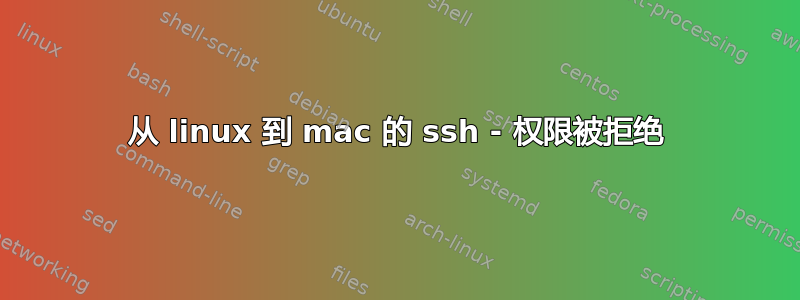
我在 Windows 7 主机上运行 Oracle Linux VM,并尝试通过 ssh 连接到我的 MacBook。
我已经在我的 Mac 中创建了私钥/公钥。我已将内容复制到文件夹中的文件id_rsa.pub中。我已将当前用户的权限更改为。和 的权限已更改为。authorized_keys.sshauthorized_keys600~~/.ssh700
我还使用以下命令将 Oracle Linux VM 中的内容复制id_rsa.pub到authorized_keys 文件中
ssh-copy-id
在我的 Mac 中,我还有一个 Oracle Linux VM,我可以从 Windows 计算机中的 Oracle Linux VM 完美地通过 ssh 连接到该 VM。
但是,我无法仅使用以下命令 ssh 进入我的 Mac:ssh macdomain
我必须使用:ssh username@macdomain 才能成功 ssh。如果没有用户名,它会要求我输入密码,最终结果是:
Permission denied (publickey, keyboard-interactive)
这是我的 sshd_config 文件:
# $OpenBSD: sshd_config,v 1.81 2009/10/08 14:03:41 markus Exp $
# This is the sshd server system-wide configuration file. See
# sshd_config(5) for more information.
# This sshd was compiled with PATH=/usr/bin:/bin:/usr/sbin:/sbin
# The strategy used for options in the default sshd_config shipped with
# OpenSSH is to specify options with their default value where
# possible, but leave them commented. Uncommented options change a
# default value.
#Port 22
#AddressFamily any
#ListenAddress 0.0.0.0
#ListenAddress ::
# The default requires explicit activation of protocol 1
#Protocol 2
# HostKey for protocol version 1
#HostKey /etc/ssh/ssh_host_key
# HostKeys for protocol version 2
#HostKey /etc/ssh/ssh_host_rsa_key
#HostKey /etc/ssh/ssh_host_dsa_key
# Lifetime and size of ephemeral version 1 server key
#KeyRegenerationInterval 1h
#ServerKeyBits 1024
# Logging
# obsoletes QuietMode and FascistLogging
SyslogFacility AUTHPRIV
#LogLevel INFO
# Authentication:
#LoginGraceTime 2m
#PermitRootLogin yes
#StrictModes no
#MaxAuthTries 6
#MaxSessions 10
#RSAAuthentication yes
PubkeyAuthentication yes
AuthorizedKeysFile .ssh/authorized_keys
AllowUsers username
# For this to work you will also need host keys in /etc/ssh/ssh_known_hosts
#RhostsRSAAuthentication no
# similar for protocol version 2
#HostbasedAuthentication no
# Change to yes if you don't trust ~/.ssh/known_hosts for
# RhostsRSAAuthentication and HostbasedAuthentication
#IgnoreUserKnownHosts no
# Don't read the user's ~/.rhosts and ~/.shosts files
#IgnoreRhosts yes
# To disable tunneled clear text passwords both PasswordAuthentication and
# ChallengeResponseAuthentication must be set to "no".
#PasswordAuthentication no
#PermitEmptyPasswords no
# Change to no to disable s/key passwords
#ChallengeResponseAuthentication yes
# Kerberos options
#KerberosAuthentication no
#KerberosOrLocalPasswd yes
#KerberosTicketCleanup yes
# GSSAPI options
#GSSAPIAuthentication no
#GSSAPICleanupCredentials yes
#GSSAPIStrictAcceptorCheck yes
#GSSAPIKeyExchange no
# Set this to 'yes' to enable PAM authentication, account processing,
# and session processing. If this is enabled, PAM authentication will
# be allowed through the ChallengeResponseAuthentication and
# PasswordAuthentication. Depending on your PAM configuration,
# PAM authentication via ChallengeResponseAuthentication may bypass
# the setting of "PermitRootLogin without-password".
# If you just want the PAM account and session checks to run without
# PAM authentication, then enable this but set PasswordAuthentication
# and ChallengeResponseAuthentication to 'no'.
# Also, PAM will deny null passwords by default. If you need to allow
# null passwords, add the " nullok" option to the end of the
# securityserver.so line in /etc/pam.d/sshd.
#UsePAM yes
#AllowAgentForwarding yes
#AllowTcpForwarding yes
#GatewayPorts no
#X11Forwarding no
#X11DisplayOffset 10
#X11UseLocalhost yes
#PrintMotd yes
#PrintLastLog yes
#TCPKeepAlive yes
#UseLogin no
#UsePrivilegeSeparation yes
#PermitUserEnvironment no
#Compression delayed
#ClientAliveInterval 0
#ClientAliveCountMax 3
#UseDNS yes
#PidFile /var/run/sshd.pid
#MaxStartups 10
#PermitTunnel no
#ChrootDirectory none
# pass locale information
AcceptEnv LANG LC_*
# no default banner path
#Banner none
# override default of no subsystems
Subsystem sftp /usr/libexec/sftp-server
# Example of overriding settings on a per-user basis
#Match User anoncvs
# X11Forwarding no
# AllowTcpForwarding no
# ForceCommand cvs server
# XAuthLocation added by XQuartz (http://xquartz.macosforge.org)
XAuthLocation /opt/X11/bin/xauth
我用谷歌搜索并查看了几乎所有相关主题,但无济于事。
答案1
您在 VM 中的用户名与 Mac 上的用户名不同。默认情况下,ssh如果您未明确指定,则假定用户名相同。它试图登录不存在(或者您尚未设置)的用户,这就是它总是失败的原因。
为了避免这种情况,您可以每次指定用户名,或者设置您的.ssh/config文件在虚拟机中像这样:
Host mac
Hostname macdomain
User yourmacusername
这将仅覆盖该主机的默认用户名。如果您愿意,也可以ssh mac不使用主机名。


